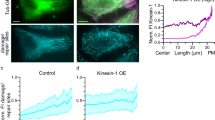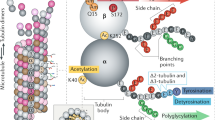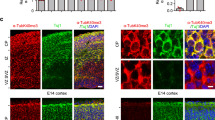Abstract
Reversible acetylation of α-tubulin has been implicated in regulating microtubule stability and function1. The distribution of acetylated α-tubulin is tightly controlled and stereotypic. Acetylated α-tubulin is most abundant in stable microtubules but is absent from dynamic cellular structures such as neuronal growth cones and the leading edges of fibroblasts1,2. However, the enzymes responsible for regulating tubulin acetylation and deacetylation are not known. Here we report that a member of the histone deacetylase family, HDAC6, functions as a tubulin deacetylase. HDAC6 is localized exclusively in the cytoplasm, where it associates with microtubules and localizes with the microtubule motor complex containing p150glued (ref. 3). In vivo, the overexpression of HDAC6 leads to a global deacetylation of α-tubulin, whereas a decrease in HDAC6 increases α-tubulin acetylation. In vitro, purified HDAC6 potently deacetylates α-tubulin in assembled microtubules. Furthermore, overexpression of HDAC6 promotes chemotactic cell movement, supporting the idea that HDAC6-mediated deacetylation regulates microtubule-dependent cell motility. Our results show that HDAC6 is the tubulin deacetylase, and provide evidence that reversible acetylation regulates important biological processes beyond histone metabolism and gene transcription.
This is a preview of subscription content, access via your institution
Access options
Subscribe to this journal
Receive 51 print issues and online access
$199.00 per year
only $3.90 per issue
Buy this article
- Purchase on Springer Link
- Instant access to full article PDF
Prices may be subject to local taxes which are calculated during checkout




Similar content being viewed by others
References
Piperno, G., LeDizet, M. & Chang, X. J. Microtubules containing acetylated α-tubulin in mammalian cells in culture. J. Cell Biol. 104, 289–302 (1987)
Robson, S. J. & Burgoyne, R. D. Differential localisation of tyrosinated, detyrosinated, and acetylated α-tubulins in neurites and growth cones of dorsal root ganglion neurons. Cell Motil. Cytoskel. 12, 273–282 (1989)
Smith, D. S. et al. Regulation of cytoplasmic dynein behaviour and microtubule organization by mammalian Lis1. Nature Cell Biol. 2, 767–775 (2000)
Wade, P. A., Pruss, D. & Wolffe, A. P. Histone acetylation: chromatin in action. Trends Biochem. Sci. 22, 128–132 (1997)
Grozinger, C. M., Hassig, C. A. & Schreiber, S. L. Three proteins define a class of human histone deacetylases related to yeast Hda1p. Proc. Natl Acad. Sci. USA 96, 4868–4873 (1999)
Guardiola, A. R. & Yao, T. P. Molecular cloning and characterization of a novel histone deacetylase HDAC10. J. Biol. Chem. 277, 3350–3356 (2001)
Luo, J., Su, F., Chen, D., Shiloh, A. & Gu, W. Deacetylation of p53 modulates its effect on cell growth and apoptosis. Nature 408, 377–381 (2000)
Ito, A. et al. p300/CBP-mediated p53 acetylation is commonly induced by p53-activating agents and inhibited by MDM2. EMBO J. 20, 1331–1340 (2001)
Sartorelli, V. et al. Acetylation of MyoD directed by PCAF is necessary for the execution of the muscle program. Mol. Cell 4, 725–734 (1999)
Kouzarides, T. Acetylation: A regulatory modification to rival phosphorylation? EMBO J. 19, 1176–1179 (2000)
Verdel, A. et al. Active maintenance of mHDA2/mHDAC6 histone-deacetylase in the cytoplasm. Curr. Biol. 10, 747–749 (2000)
Barlow, A. L. et al. dSIR2 and dHDAC6: two novel, inhibitor-resistant deacetylases in Drosophila melanogaster. Exp. Cell Res. 265, 90–103 (2001)
Piperno, G. & Fuller, M. T. Monoclonal antibodies specific for an acetylated form of α-tubulin recognize the antigen in cilia and flagella from a variety of organisms. J. Cell Biol. 101, 2085–2094 (1985)
Furumai, R. et al. Potent histone deacetylase inhibitors built from trichostatin A and cyclic tetrapeptide antibiotics including trapoxin. Proc. Natl Acad. Sci. USA 98, 87–92 (2001)
Wadsworth, P. Regional regulation of microtubule dynamics in polarized, motile cells. Cell Motil. Cytoskel. 42, 48–59 (1999)
Waterman-Storer, C. M. & Salmon, E. Positive feedback interactions between microtubule and actin dynamics during cell motility. Curr. Opin. Cell Biol. 11, 61–67 (1999)
Kaverina, I., Krylyshkina, O. & Small, J. V. Microtubule targeting of substrate contacts promotes their relaxation and dissociation. J. Cell Biol. 146, 1033–1044 (1999)
Seigneurin-Berny, D. et al. Identification of components of the murine histone deacetylase 6 complex: Link between acetylation and ubiquitination signalling pathways. Mol. Cell. Biol. 21, 8035–8044 (2001)
Hicke, L. A new ticket for entry into budding vesicles—ubiquitin. Cell 106, 527–530 (2001)
Eckner, R., Yao, T. P., Oldread, E. & Livingston, D. M. Interaction and functional collaboration of p300/CBP and bHLH proteins in muscle and B-cell differentiation. Genes Dev. 10, 2478–2490 (1996)
Malinda, K. M., Ponce, L., Kleinman, H. K., Shackelton, L. M. & Millis, A. J. Gp38k, a protein synthesized by vascular smooth muscle cells, stimulates directional migration of human umbilical vein endothelial cells. Exp. Cell Res. 250, 168–173 (1999)
Acknowledgements
We thank A. R. Means, A. M. Pendergast and A. M. J. Van Dongen, as well as the members of the Yao laboratory, for their insightful discussions and critical reading of the manuscript; A. M. Pendergast for pointing out the similarity between HDAC6 and p150glued; and J. Gross and H. Solari for technical assistance with the confocal microscopy. X.F.W. was supported by an NIH grant, as was A.N. (to P. J. Casey). This work is supported by funding from the Damon Runyon–Walter Winchell Cancer Foundation and the Department of Defense to T.-P.Y.
Author information
Authors and Affiliations
Corresponding author
Ethics declarations
Competing interests
The authors declare that they have no competing financial interests.
Rights and permissions
About this article
Cite this article
Hubbert, C., Guardiola, A., Shao, R. et al. HDAC6 is a microtubule-associated deacetylase. Nature 417, 455–458 (2002). https://doi.org/10.1038/417455a
Received:
Accepted:
Issue Date:
DOI: https://doi.org/10.1038/417455a
This article is cited by
-
Emerging roles of prominin-1 (CD133) in the dynamics of plasma membrane architecture and cell signaling pathways in health and disease
Cellular & Molecular Biology Letters (2024)
-
Microtubule damage shapes the acetylation gradient
Nature Communications (2024)
-
Linking acetylated α-Tubulin redistribution to α-Synuclein pathology in brain of Parkinson’s disease patients
npj Parkinson's Disease (2024)
-
Emerging therapeutic strategies in cancer therapy by HDAC inhibition as the chemotherapeutic potent and epigenetic regulator
Medical Oncology (2024)
-
Dysfunction in parkin aggravates inflammatory bone erosion by reinforcing osteoclast activity
Cell & Bioscience (2023)
Comments
By submitting a comment you agree to abide by our Terms and Community Guidelines. If you find something abusive or that does not comply with our terms or guidelines please flag it as inappropriate.



